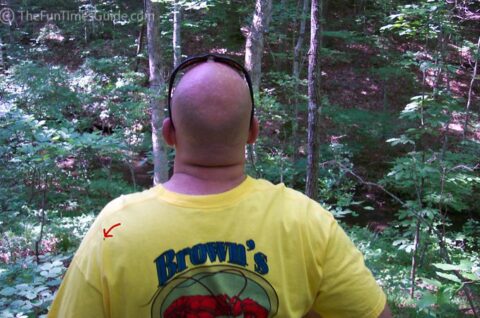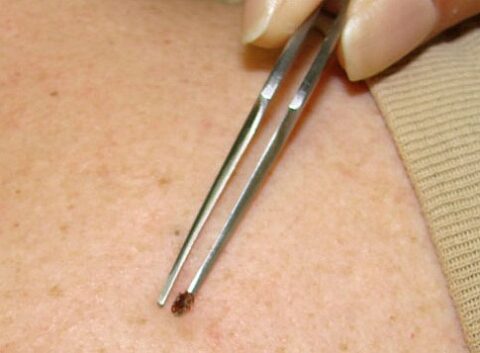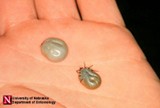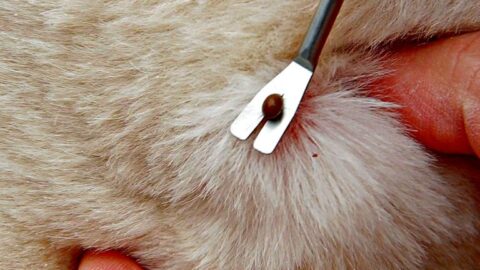In our never-ending quest to find property on which to build our new house, we’ve been traipsing in… through… up… and over… tall, thick brush filled with ticks!
This isn’t our first experience with ticks though. We’ve done our fair share of hiking, camping, and property searching together in Tennessee and Florida (where we’ve lived) and across the USA (where we’ve traveled together).
Needless to say, I know a good deal about ticks and tick bites. (And… I have Lyme Disease. More on that in a minute.)
Following are my best tips — so you’ll know what to look for and what to do if you ever get a tick bite, including:
- What I’ve learned about the dangers of ticks (…like not all ticks carry the dreaded Lyme Disease).
- Which type of ticks are the most dangerous ones to look for in each area of the U.S.
- How tick bites affect dogs.
- How long ticks feed on your blood — or your dog’s blood.
- My personal experience with tick bites, the bullseye rash, and Lyme Disease.
- The best way to remove a tick — easy ways to remove ticks and how to get a tick off yourself or your dog quickly.
All About Tick Bites
There are a number of experts who have compiled lists of what Lyme Disease ticks look like, how to remove ticks, and how to prevent tick bites.
My favorite ones are here:
- Tick Identification: Which Type Bit You?
- All About Ticks
- A U.S. Map Showing Ticks That Bite & Where You’ll Find Them
- How To Identify Different Ticks
- A List Of Tickborne Diseases In The United States
In my opinion, these are the biggest takeaways regarding ticks:
- Once they attach, ticks will feed on your blood and become engorged over a period of 72 to 96 hours.
- They say that a tick’s favorite areas on the human body are the armpits and groin area. But on Jim and I, ticks seem to prefer our legs (especially the calves and ankles), knees (front and back), and waist (especially at the underwear lines).
- FYI, we were always wearing long pants and DEET
— yet we still got bit by a lot of ticks! We switched to using Permethrin instead of DEET and found that it works much better. (More on that below.)
The degree of engorgement reflects the time the tick was attached. Unengorged corresponds with ~0 hours, slightly engorged with ~24 hours, moderately engorged with ~48 hours, and very engorged with ~72 or more hours. If the tick is infected with Lyme Disease bacteria, the risk of contracting Lyme Disease is considered minimal if the tick is unengorged, slight if slightly engorged, and likely if moderately or very engorged … It takes 2 to 3 days for nymphs and 4 to 7 days for adults to become fully engorged. Usually it takes 36 hours for a tick to infect you, IF it has Lyme bacteria. Remember, not all deer ticks are infected. Source
Which Ticks Carry Lyme Disease?
In the northeastern, mid-Atlantic, and north-central United States… it’s the blacklegged tick (or deer tick) that spreads Lyme Disease.
On the Pacific Coast… it’s the western blacklegged tick that spreads Lyme Disease.
Blacklegged Ticks (or Deer Ticks) are the main carriers of Borrelia bacteria. So if your child has a Brown Dog Tick, a Rocky Mountain Wood Tick, or a Lone Star Tick, you don’t have to worry about Lyme Disease. But these other types of ticks can carry different kinds of disease-causing bacteria — so it’s good to know which tick you’re dealing with … Always remember to save the tick. That’s the most important thing. Source
Here are lots of photos of ticks — so you can see what Deer Ticks and Western Blacklegged Ticks look like, compared to other types of ticks that do not carry Lyme Disease.
My Own Experience With Tick Bites
Judging from the above information, my husband and I (and our dogs) have been bitten mostly by Lone Star Ticks — and we’ve been bitten by plenty of Tick Larva, too!
Before this summer, I had never seen ticks as small as the ones we pulled off our legs, arms, and other parts.
Apparently these are Tick Larva or Nymphs, and I’m here to tell you… they leave the itchiest bite of all! These tiny ticks are fairly easy to pull off your skin, but the itch lingers on for days — even weeks.
There for awhile, my skin kept bruising from all the scratching that I was doing. These little buggers pack a mighty bite! Then I started using Benadryl and applying Cortaid to the bite — and the itching went away much faster.
For the record, most of the ticks we pulled off our dogs this summer were Dog Ticks and Lone Star Ticks, as seen here:
Neither Lone Star Ticks nor Dog Ticks are carriers of Lyme Disease.
Since the tiniest ticks Jim & I pulled of ourselves were more brown than black in color, I can only guess that they were probably not the Deer Ticks that are responsible for Lyme Disease.
How To Remove A Tick From Yourself Or Your Dog
The #1 tip I’ve learned about ticks is the best way to remove a tick from your skin! So I thought I’d share.
Here is easiest and safest way to remove a tick:
First, using tweezers, grasp the tick as close to its head as possible. (Not the tick’s back, which is the largest and easiest to grab.) Gently lift the tick away from your skin until your skin puckers. Hold the tick in this position until the tick lets go. This may take a few seconds to 1 minute. Source
With the rise of Lyme Disease, there’s been an increase in the number of tools & gadgets that are available to remove ticks from your own body — and from your pet’s body.
There are many tick removers and tools that are useful for removing ticks — but my all time favorite is TickEase. It’s the only dual-sided tick removal tool on the market.
Here’s why I like TickEase:
- One end has super-fine “pointy” tweezers — for removing ticks from humans (even tiny ticks)
- The other end has a slotted “scoop” — for removing ticks from pets (handy, since my dogs get ticks every year when we’re out hiking and the slotted end holds the dog’s fur out of the way)
- The pointy tweezers on TickEase lie flat against your skin (unlike most pointy tweezers) — making it easy to get underneath the tick and remove the tick’s mouth
- The TickEase tool keeps the mouth parts of the tick intact — so the entire tick is removed and no parts remain embedded in the skin
- The tick remains contained within the tweezer or the slotted scoop — rather than flying across the room or falling to the floor
- It’s inexpensive at less than $10
- TickEase was designed to comply with the CDC’s tick removal guidelines, which recommends pointy tweezers instead of flat-tipped ones for removing ticks from humans
The truth is that traditional household tweezers are designed for the removal of slivers. They are no more appropriate for removing ticks from your skin than are fine-tipped TickEase tweezers for removing slivers. In fact, using household tweezers to remove an engorged tick increases the chances of tearing the tick, which just exacerbates the problem. And they are certainly not effective for removing tiny nymph-stage ticks. Source
This video shows the inventor of TickEase, how this tick removal tool was made, and how to use TickEase to remove ticks from humans:
https://youtu.be/eg8EZpDinKU?t=19s
The takeaway: Dan is a tick expert. He recommends using the fine-tipped tweezers end to get under the tick, against your skin and over the tick’s mouth parts. That way, you can easily pull it straight out of your skin. (NOTE: Do not twist — doing so can cause the mouth parts to break of and remain in the skin.)
See how to use TickEase to remove ticks from dogs:
https://www.youtube.com/watch?v=Dkxx5J_-raw&feature=youtu.be&t=37s
The takeaway: Using the scoop end, simply place it against your dog’s skin, slide it underneath the tick, and lift with steady even pressure.
See how to use TickEase to remove tick from from children:
https://www.youtube.com/watch?v=yT75wJSx5hw&feature=youtu.be&t=14s
The takeaway: Use the fine-tipped tweezers end to get under the tick, against the skin and over the tick’s mouth parts. That way, you can easily pull it straight out of the skin.
Here are the official instructions for using the TickEase Tick Removal Tool.
How To Remove A Tick Without Tweezers Or A Tool
A few people have asked the best way to remove a tick without tweezers or a tick removal tool.
Maybe you’re out in the woods and you notice a tick on your dog — but you don’t want the tick feasting on your dog for hours until you can get to a tick removal tool.
While I don’t recommend this method, here’s a video showing how to remove a tick from a dog without tweezers:
The Bottom Line…
Well, I told ya we’ve had our fair share of tick bites — right?
It turns out one of the ticks that bit me was either a Deer Tick or a Western Blacklegged Tick — because I have Lyme Disease now. Since we live in Tennessee (and before that, we lived in Florida), most likely it was a Deer Tick.
Our best guess is that my Lyme Disease came from a tick bite I remember over 6 months ago. I had a red rash about the size of a golf ball — and I took a picture of it — but back then I didn’t put the pieces together that it could actually be Lyme. It wasn’t until 6 months after that rash from a tick bite that I started experiencing the symptoms of Lyme Disease.
Here’s what the Lyme Disease rash looks like.
Since I was diagnosed with Lyme Disease:
- Every time one of us gets a tick bite, I’m careful to follow the best way to remove a tick that I’ve shared above.
- We’ve discovered another product that prevents tick bites better than DEET — it’s called Permethrin.
- I also learned that you can get Lyme Disease from your dog. Mine was obtained directly from a tick, not from my dog — but here’s how to tell if your dog has Lyme Disease from a tick bite.
Here’s a little about my personal experience — what it’s like living with Lyme Disease.
So I guess the bottom line is…
- Check yourself and your pets for ticks any time you and/or your dogs have spent time outdoors where ticks reside. Here’s how to check for ticks on your body.
- Have a plan for quick & easy tick removal — know where your tick removal tweezers are and how to get a tick out yourself.
- Save any ticks that you remove — in case you eventually experience a rash or you start to have any unusual health symptoms. These days, most doctors have access to the tests to check ticks for diseases. You could also send the tick out for tick testing, but this generally isn’t recommended.














